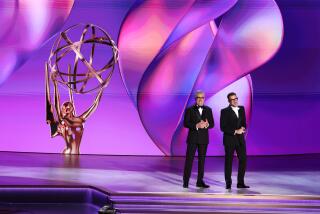Bingeing on the many ways to watch TV
- Share via
In the opening segment of Sunday’s 65th Primetime Emmy Awards, host Neil Patrick Harris said the industry had gathered to celebrate the best in television.
“For our younger audience, that’s the thing you watch on your phones,” Harris quipped.
Another bit in the opening segment had Harris trying to binge-watch every episode of every TV series simultaneously, a practice made popular by the video service Netflix.
Emmys 2013 full coverage: Best & worst moments | Winners / nominees | Red carpet video | Quotes from the stars | Show highlights | Red carpet arrivals | Timeline | Photo booth
The humor highlighted the crux of the television industry’s dilemma: Technology has rapidly changed the way consumers watch TV, as the landscape has become increasingly crowded with services that compete with the traditional TV networks for viewers. The networks’ challenge is to figure out how to exploit these digital platforms without steering viewers away from their own channels and jeopardizing the billions of dollars they collect each year in ad revenue and fees from cable distributors.
“I don’t think the word ‘Netflix’ was spoken during the broadcast, but the entire subtext of that opening sketch was Netflix,” said Ted Sarandos, the company’s chief content officer. “That was pretty amazing.”
Some pundits had expected Netflix’s political thriller “House of Cards” to win big at this year’s event. Instead, the drama “Breaking Bad” on cable channel AMC and the sitcom “Modern Family” on ABC won the top honors Sunday night. Industry titan HBO scored the most Emmys — 27 — while CBS had the second-highest haul with 16.
After winning best drama for “Breaking Bad,” the show’s creator, Vince Gilligan, credited Netflix for helping establish an audience for the show after early seasons did not perform strongly in the Nielsen ratings.
“Netflix kept us on the air,” Gilligan said.
ON LOCATION: Where the cameras roll
That’s in part because Netflix, Amazon.com, Hulu and other video-on-demand options have given viewers the chance to catch up on shows, particularly serialized dramas, that they may have missed the first time around.
The number of homes equipped with digital video recorders also has greatly expanded. Now nearly half of all TV homes in the U.S. have the technology, up from 19% in 2008, according to Nielsen.
“Viewers are not just wedded to a linear television schedule,” said Bruce Rosenblum, chairman of the Academy of Television Arts & Sciences. “Viewers are the beneficiaries of these technological developments.”
Catch-up viewing also can drive people back to the TV network that originally televised the show.
“Breaking Bad,” which ends its run on AMC next week, has enjoyed record ratings this season after thousands of viewers streamed episodes through Netflix. Sunday night’s penultimate episode attracted nearly 7 million viewers — even though it played opposite the Emmy telecast on CBS.
In fact, Sarandos said, the most-watched program on Netflix on Sunday night was the 2008 pilot episode of “Breaking Bad.”
PHOTOS: Highest-paid media executives of 2012
“That means that new people who have never seen a single episode of ‘Breaking Bad’ are checking it out,” the executive said.
“It is a pretty interesting moment in how people are consuming television,” said AMC President Charles Collier. “The entire ecosystem is functioning in a way that really helps television.”
But at the same time, Netflix and Amazon are increasingly becoming competitors to ABC, AMC, CBS, HBO and Showtime, attracting viewers as well as some of Hollywood’s A-list producers, directors and writers.
The percentage of homes that have Netflix subscriptions increased to 38% of the country this year, up from 31% of homes in 2012, according to a recent Nielsen report. Amazon’s video service Amazon Prime Instant Video increased to 13% of the market, up from 7% a year ago. At the same time, 88% of the Netflix viewers surveyed said they watched three or more episodes of the same show on the same day.
“House of Cards” was the first program created for online video service to be nominated for television’s top honors.
“There is no doubt that Netflix is becoming an important player, and they should be commended for the quality of their shows,” Rosenblum said. “But we should not lose sight of the fact that the great majority of television viewing is on broadcast and cable channels.”
PHOTOS: Hollywood backlot moments
Not everyone considers Netflix a friend. Showtime and HBO — in an effort to safeguard their primary revenue of monthly subscriptions — do not license their programs to Netflix over concerns it would dilute the value of their own services.
But these new platforms and their insatiable appetite for content have also become a vital source of revenue for producers and networks. The CBS series “Under the Dome,” which ran this summer, was a financial success before an episode ever aired in large part because CBS had struck a deal with Amazon, which secured rerun rights to the show later in the week after an episode ran on CBS.
Broadcasters must still be able to translate the new viewership opportunities into revenue. Last week, Fox premiered a new drama called “Sleepy Hollow,” which averaged 10 million viewers. Over the next three days, the show added an additional 3 million viewers from recorded viewing. By the end of the month, Fox projects that the audience could grow to as much as 16 million.
But advertisers pay a premium for shows that are watched in real time, and they are less interested in paying for delayed views because so many people fast-forward through the commercials.
Broadcasters are agitating for advertisers to put greater value on delayed viewing, which is increasingly common.
“There are more ways to watch television than ever before,” said David Nevins, president of entertainment for the Showtime Networks, which collected seven Emmys. He noted that only about 30% of the viewing of his network’s popular “Dexter” occurs during the first run of an original episode.
The quality of content continues to be the biggest driver, he said.
“The only conclusion that you could draw from the Emmy awards is there is really good television coming from a lot of different places,” Nevins said. “The diversity of the wins Sunday night demonstrates that many networks are turning out great programs.”
More to Read
From the Oscars to the Emmys.
Get the Envelope newsletter for exclusive awards season coverage, behind-the-scenes stories from the Envelope podcast and columnist Glenn Whipp’s must-read analysis.
You may occasionally receive promotional content from the Los Angeles Times.












